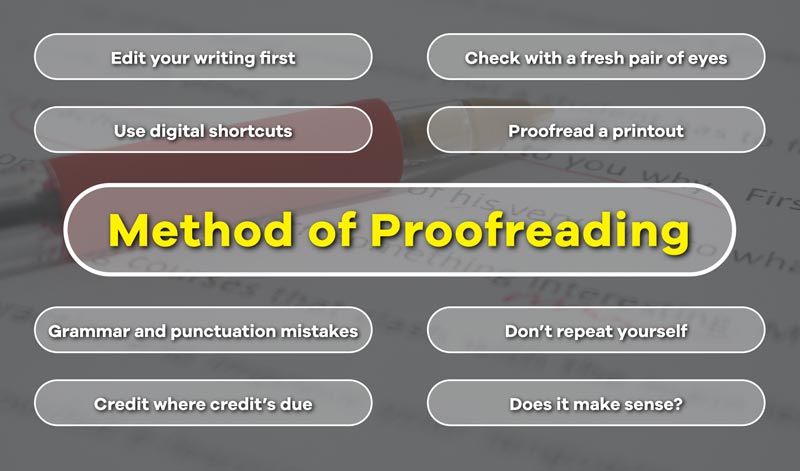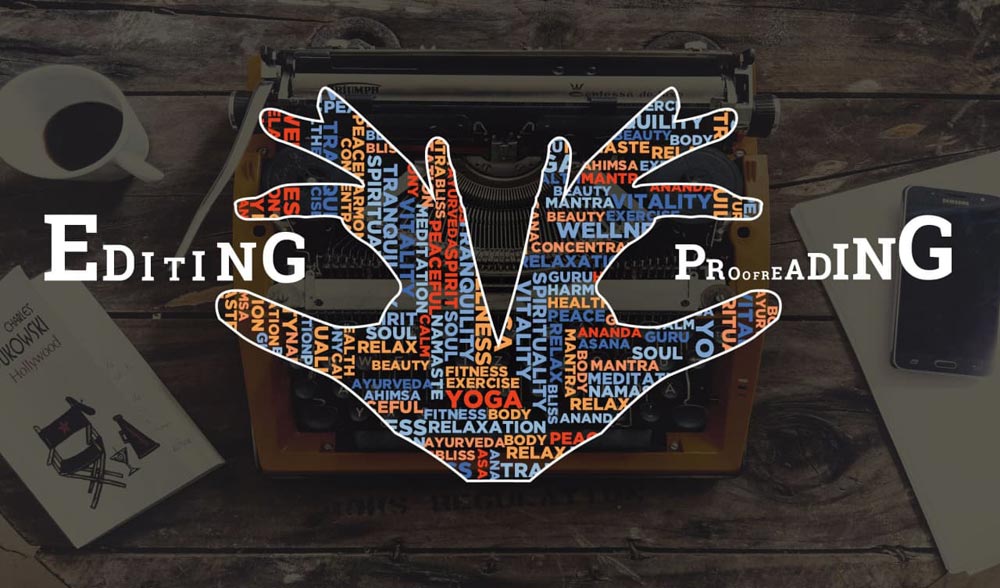Method of Proofreading

If writing is an art, proofreading is the final polish to it. There are a few ways better than others that you can effectively proofread a piece of writing. The steps listed below will help keep track of things you are doing right and wrong. The key is to not miss any steps and do them with the most care before moving on to the next one. The specific areas to look for in your writing are also listed after the steps so that the process becomes a bit easier when you get to the proofreading phase.
Steps of proofreading
The steps below can be seen through one by one while proofreading so that none of these slips off your mind. Some are things to do while some are things to keep in the back of your mind while you proofread your writing.
Edit your writing first
Editing is to make monumental changes in your written piece like which chapter goes where and what portion to cut off. At this stage, after you are happy with your content, you decide how it looks at the end. Upon taking these big decisions, proofreading comes next. Proofreading starts where editing finishes. Proofreading deals with the finer changes and fixes required inside your writing. Do not start proofreading before editing or you will be doing similar things a few times over while wasting precious time.
Check with a fresh pair of eyes
Sitting in front of the same writing for hours will trick your eyes without fail. It gets harder to spot mistakes and inaccuracies when you keep staring at the same set of words for hours or days on end. One thing to do is to divert attention to something entirely else for a number of hours or days. One rule is to NOT sit in front of the writing in question for a long period of time. After this pre-set period ends, start looking through that piece again with a fresh pair of eyes and a clear mindset. You'll find the discrepancies hidden deep inside it more easily than before and it will take a lot less time.
Use digital shortcuts
There are a few easy digital shortcuts you can take while writing. Spell Checker etc. digital proofreading tools are absolute golds for very basic errors. These automated error checks save tons of your time and toil so that you can concentrate on the more significant tasks at hand. Proofreading is hard work on its own, you do not need added hurdles on your way.
Proofread a printout
Proofreading a printed-out copy always works best. Looking at your screen may prove to be pretty tough when it continues for hours or days. The trick is to print it out once the writing and editing phase is done and dusted. There are a few special signs and marks that the proofreaders use to do their job on point. These signs help them get it right in the next copy with the most precision possible.
Grammar and punctuation mistakes
Grammar and punctuation mistakes can downgrade the quality of your writing a great deal. Keeping a close eye on such mistakes is key while working on formal or publish-worthy copy for a sheer show of professionalism and sincerity if not anything else. It goes without saying that such details help keep hold of the readers' concentration which is always highly important.
Don’t repeat yourself
Some focus greatly upon keeping a high word count while writing something thinking it ups the value of the writing in concern. It could not be further from the truth if you are having to repeat yourself over and again in various ways just to add to the words required to get your point across.
Credit where credit’s due
Writing has a lot to do with researching well. Researching is skill sourced by many. Adding the researched materials into your written piece is crucial when it comes to giving credit to the right party. While researching, one has to keep digging deep until they find the root source of the information s/he needs. Upon finding the right source, extending due credit will increase the credibility of your writing. It will also showcase your researching skills aptly.
Does it make sense?
Having someone who likes to read but lacks any background knowledge of what you are writing, read your piece after all the editing and proofreading works are done would be the best way forward. S/he will tell you best if it all makes sense or not. Their fresh perspective will put the writing to the best possible test possible.
What to look for while proofreading?
Confusing words
There are a few very confusing words that make for the most common mistakes in writing. Homophones (i.e. they're - their - there and your - you’re) are one of the most problematic ones that most writers fall victim to while fully aware or during their slip in focus. Articles and Prepositions are the next culprits. Which of them goes where tricks the best of writers every now and then. Proofreading can make sure these slips are non-existent in the finished and proofread copy.
Punctuations
Punctuations are highly significant in nature when it comes to conveying facts and points precisely without any misunderstanding. Commas and Apostrophes can confuse the brains out of the lot. Hyphens and Dashes are no different either. While writing, always getting the right 100% of the time is impossible but if you look for them during proofreading the task becomes way simpler.
Stylistic Consistency
There are a few stylistic errors that are absolutely detrimental to your writing endeavours. Mixing up UK and US-style English spellings are among the most common and most crucial ones. Capitalization is another key stylistic element in your writing with the wrong usage of which the message in your piece can mean something entirely different from what you intended. Numbers used as digits or their spelled-out counterparts can aid to the stylistic side of things a great deal. Focusing on these while proofreading can result in a uniform font and style in your written piece.
Correct Formatting
Formatting a piece of writing correctly will always make it look polished and in turn, express sincere effort. Formatting would mean if all the indentations and spacing are uniform and spot on so that nothing looks out of place on paper. Quotations and citations require separate formatting but the trick is to get all the quotations and citations to look the same. Page numbers, headers, footers are usually pretty easy to deal with so better leave it for the proofreading phase altogether.
Once a piece of writing is proofread to perfection, it is bound to make an impeccable impression on its readers in terms of professionalism and standard. That is exactly why proofreading is an essential yet unmissable part of the writing process. Focusing on the finest details during the proofreading phase will save you a ton of inconvenience.
Grammar
Read More
- How to Use "Therefore" in Sentences Avoiding Common Mistakes
- How to Use "Whereas" with Examples and Avoid Common Mistakes
- When and How to Use "Thus" Correctly Without Common Mistakes
- How to Use "On the Contrary" Properly with Meaning and Examples
- When and How to Use "Either/Or" with Examples and Common Mistakes to Avoid
- How to Use "On the Other Hand" Effectively without Mistakes
- How to Use "Respectively" with Example and Common Errors to Avoid
- How and When to Use "Moreover" Without Mistakes
- How to Use "Likewise" in Sentences Based on Context & When not to Use
- When & How to Use "Although" in Sentences to Avoid Mistake

